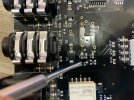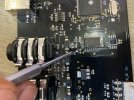Soren Kelly
Well-Known Member
Hi can anyone help
I have 2 ext dbl switch
when set up 1/2 for preset up/down it will work fine with both dbl-footswitches with 2 different cables
When i set up 3/4 for the same only 1 switch works on the dblswitch
does that make sens
I have 2 ext dbl switch
when set up 1/2 for preset up/down it will work fine with both dbl-footswitches with 2 different cables
When i set up 3/4 for the same only 1 switch works on the dblswitch
does that make sens



